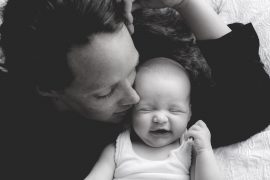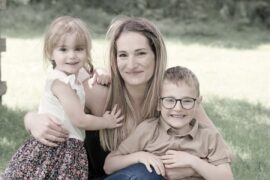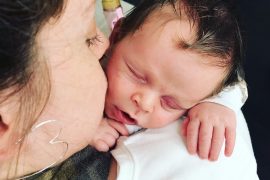STRESS CYCLE
Stress is the impact that our bodies experience when emotionally or physically challenged. The ability to handle stress is formed via our early experiences (Perry et al 1995). Subjection to repeated, frequent, ongoing or intense stressors leaves a baby prone to not only the negative effects of that experience but to a trajectory of future vulnerability to stressful events. For an infant, crying is typically the only way they have to communicate their stress. With adults, the ‘fight or flight’ response mobilizes our bodies to handle difficult or potentially overwhelming situations; for a baby, fight or flight only works if someone comes to fight for or flee with them (Perry 2001). Hence, leaving them to cry only increases their stress levels, teaches them they cannot rely on their caregivers for assistance, and opens them to the cycle of hyperarousal and dissociation that characterises the stress response.
When babies experience persistent or intense stress, they enter a cycle of hyperarousal and dissociation (Perry et al 1995). The initial stage of the stress cycle is one of hyperarousal, that is, the ‘startle’ reaction to a threat. This reaction engages the sympathetic nervous system, which increases the heart rate, blood pressure and respiration rate. Distress at this stage is usually expressed by crying, which will progress to screaming. The brain attempts to mediate this by increasing the levels of major stress hormones: adrenaline, noradrenaline, and dopamine. Elevated hormone levels trigger a hypermetabolic state in the developing brain (Brown 1982). This state can have negative consequences since the release of stress hormones is only a short term protective mechanism aimed at assisting the body in surviving a dangerous situation. Prolonged periods spent in this state are damaging. Additionally, prolonged exposure to stress induces increased levels of thyroid hormones and vasopressin (Schore 1994). Vasopressin, a hypothalamic neuropeptide, is released in response to unsafe or challenging environments (Schore 2002). It is also associated with nausea and vomiting, which may explain why many babies throw up after extended crying (Beebe 2000). The second, later-forming reaction to stress is one of dissociation. At this point, the baby disengages from the external stimuli and retreats to an internal world. This second phase involves numbing, avoidance, compliance and lack of reaction (Schore 2002), and occurs in the face of a stressful situation in which the baby feels both hopeless and helpless (Schore 1994). The infant tries to repair the disequilibrium but cannot so s/he disengages, becomes inhibited, and strives to avoid attention in an effort to become ‘unseen’ (Schore 1994). This metabolic shutting down is a passive state in response to an unbearable situation and is the opposite of hyperarousal. In biological terms, it is the same process that allows us to retreat from overwhelming situations in order to heal wounds and fill depleted resources. However, as a response to caregiver misattunement and non-responsiveness, it is devastating and the effects of even short periods of dissociation can be profound (Tronick & Weinberg 1997). In this state, pain numbing endogenous opiates and behavior-inhibiting stress hormones, such as cortisol, are elevated. Blood pressure decreases, as does the heart rate, despite still-circulating adrenaline (Schore 2002). This ultimate survival strategy allows the baby to maintain basic homeostasis (Porges 1997).
When babies are in distress, their brains are at the mercy of these circulating chemicals. Hence, all their regulatory resources must be devoted to trying to reorganize and regain equilibrium (Tronick & Weinberg 1997). These kinds of biochemical alterations in a rapidly developing brain can have lasting consequences. In the infant, ‘states become traits’ so that the effects of early relational traumas become part of the structure of the forming personality (Perry et al 1995). This distress is all taking place at a time when the brain is at its maximum vulnerability to influences and stimuli. Hence, while this stress reaction is going on, the infant brain must devote all its resources to managing the stress and forfeits potential opportunities for learning at the critical periods of brain development (Schore 2001). Chronic shifts into this cycle of stress can cause brain impairment and damage (McEwen 2000). It is then quite apparent that advising parents to allow their babies to cry and become distressed in an effort to get them to sleep is information which may place babies at risk. Babies are unable to make sense of a parent who is attentive at certain times of the day but unresponsive at others. Attachment research by Sroufe (1995) has shown that inconsistent or unresponsive care is associated with insecure attachments, suboptimal child development, cognitive and emotional functioning and mental health impairment. Additionally, neurological studies show that the pain of emotional separation registers the same way as physical pain (Panksepp 2003). The pain a baby experiences at being left alone to cry is truly quite intense.
CONCLUSION
If we want to teach our babies to regulate their emotions and behaviours, achieve mental health and gain the skills for happy, mutual relationships, we must do this through sensitive and responsive caregiving. This kind of caregiving in the first years of life becomes a powerful regulator of stress hormones and responses that follows a child throughout life (Gunnar &Cheatham 2003). Additionally, sleep training poses a threat to the attachment relationship by teaching parents to desensitize themselves to their baby’s cues, promoting false understandings and lack of connection. When babies express distress but are met with non-responsiveness or rejection, they learn to divert the expression of their basic needs in order to preserve some sort of connection, thus losing authentic communication with their parent (Powell et al 2007). Parenting a child, the context in which it occurs and how well it is done is a human relationship that alters the characters of both partners in the relationship (Karen 1994). Thus, it is not just the baby, but also the entire relationship that is potentially jeopardised by sleep training. It is, therefore, by meeting our babies’ needs that they learn healthy independence, including sleep independence.
Babies’ sleep and sleeping arrangements should be approached with the utmost care, without subjecting babies to separations or non-responsiveness that lasts longer than they can manage. Families must choose what is appropriate for their unique circumstances, values and culture. Regardless of choice, however, we now have a substantial body of neurological, psychological and biological research to help frame that choice, allowing us to understand the critical importance of maintaining attuned connection to our babies, regardless of time of day.
ABOUT THE AUTHOR
Lauren Porter is a clinical social worker, consultant and psychotherapist, as well as Co-Director of the New Zealand based Centre for Attachment. She holds a BA in East Asian Studies and a Masters Degree in Social Work. Since receiving her MSW in 1995 she has been dedicated to working with families, children and adolescents in the field of mental health counseling and training. Lauren has worked in a wide range of settings and communities, including Germany and the US, in addition to New Zealand. Her experience has focused on families struggling with issues pertaining to conflict and trauma, including child sexual abuse. Her current professional focus is the merging of attachment theory with neuroscientific data, with an eye toward the practical applications of everyday life. She is a member of the Attachment Parenting International Research Group, an Executive Committee member of Infant Mental Health Association Aotearoa New Zealand and a consultant for the 2006 and 2007 Nought to Five television series (TVNZ/Homegrown TV New Zealand). She is the mother of two children.
Photography: Tessa Russell – Moemoea Collective










